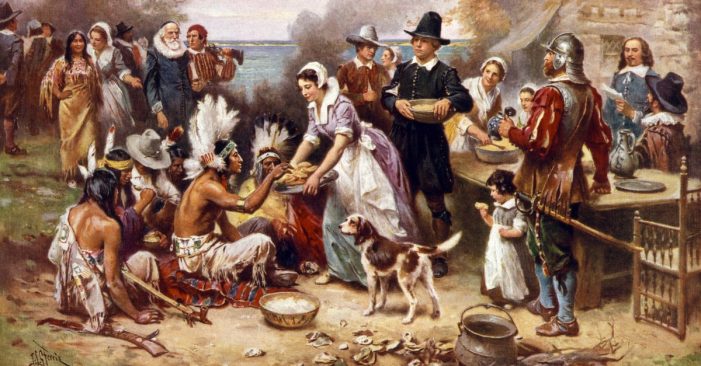By Áine Cain and Joey Hadden, Insider
While celebrations may look different this year in light of the ongoing pandemic, typically Thanksgiving is a time for family, parades, lots of delicious food, and, oftentimes, intense travel snarls.
American schoolchildren are usually taught that the tradition dates back to the pilgrims, English religious dissenters who helped to establish the Plymouth Colony in present-day Massachusetts in 1620.
As the story goes, friendly local Native Americans swooped in to teach the struggling colonists how to survive in the New World. Then everyone got together to celebrate with a feast in 1621.
Attendees included at least 90 men from the Vamping tribe and the 50 or so surviving Mayflower passengers, according to TIME.
The bash lasted three days and featured a menu including deer, fowl, and corn, according to Smithsonian Magazine.
In reality, Thanksgiving feasts predate Plymouth — a number of localities have tried to claim the first Thanksgiving for themselves.
And the peace brokered at Plymouth didn’t last long.
The real story behind the holiday is so dark, in fact, that some people are rethinking how they celebrate the holiday, or if they should at all.
The Plymouth Thanksgiving of 1621 wasn’t the first.
Settlers in Berkeley Hundred in Virginia decided to celebrate their arrival with an annual Thanksgiving back in 1619, according to National Geographic — although The Washingtonian reported the meal was probably little more than some oysters and ham thrown together.
Decades before that, Spanish settlers and members of the Seloy tribe broke bread with salted pork, garbanzo beans, and a Mass in 1565 Florida, according to the National Parks Service.
Our modern definition of Thanksgiving revolves around eating turkey, but in past centuries it was more of an occasion for religious observance.
The storied 1621 Plymouth festivities live on in popular memory, but the pilgrims themselves would have likely considered their sober 1623 day of prayer the first true “Thanksgiving,” according to the blog the History of Massachusetts.
Others pinpoint 1637 as the true origin of Thanksgiving, owing to the fact Massachusetts colony governor John Winthrop declared a day of thanks-giving to celebrate colonial soldiers who had just slaughtered 700 Pequot men, women, and children in what is now Mystic, Connecticut.
Either way, the popular telling of the initial harvest festival is what lived on, thanks to Abraham Lincoln.
The enduring holiday has also nearly erased from our collective memory what happened between the Wampanoag and the English a generation later.
Tensions grew between the Wampanoag and the English settlers years after the Plymouth Thanksgiving.
Massosoit, the sachem or paramount chief of the Wampanoag, proved to be a crucial ally to the English settlers in the years following the establishment of Plymouth. He set up an exclusive trade pact with the newcomers and allied with them against the French and other local tribes like the Narragansetts and Massachusetts.
However, the alliance became strained over time.
Thousands of English colonists poured into the region throughout the 17th century. According to “Historic Contact: Indian People and Colonists in Today’s Northeastern United States,” authorities in Plymouth began asserting control over “most aspects of Wampanoag life,” as settlers increasingly ate up more land.
The Gilder Lehrman Institute of American History estimated disease had already reduced the Native American population in New England by as much as 90% from 1616 to 1619, and indigenous people continued to die from what the colonists called “Indian fever.”
By the time Massasoit’s son Metacomet — known to the English as “King Philip” — inherited leadership, relations had frayed. King Phillip’s War was sparked when several of Metacomet’s men were executed for the murder of Punkapoag interpreter and Christian convert John Sassamon.
Wampanoag warriors responded by embarking on a series of raids, and the New England Confederation of Colonies declared war in 1675.
The initially neutral Colony of Rhode Island and Providence Plantations was ultimately dragged into the fighting, as were other nearby tribes like the Narragansetts.
Peace between the Wampanoag and the English settlers didn’t last.
The war was bloody and devastating.
Springfield, Massachusetts was burned to the ground. The Wampanoag abducted colonists for ransom. English forces attacked the Narragansetts on a bitter, frozen swamp for harboring fleeing Wampanoag.
Six hundred Narragansetts were killed, and the tribe’s winter stores were ruined, according to Atlas Obscura. Colonists in far-flung settlements relocated to more fortified areas while the Wampanoag and allied tribes were forced to flee their villages.
The colonists ultimately allied with several tribes like the Mohigans and Pequots, despite initial reluctance from the Plymouth leadership.
Meanwhile, Metacomet was dealt a staggering blow when he crossed over into New York to recruit allies. Instead, he was rebuffed and attacked by Mohawks. Upon his return to his ancestral home at Mount Hope, he was shot and killed in a final battle.
The son of the man who had sustained and celebrated with the Plymouth Colony was then beheaded and dismembered, according to “It Happened in Rhode Island.” His remaining allies were killed or sold into slavery in the West Indies. The colonists impaled “King Phillip’s” head on a spike and displayed it in Plymouth for 25 years.
In an article published in The Historical Journal of Massachusetts, Montclair State University professor Robert E. Cray Jr. said the war’s ultimate death toll could have been as high as 30% of the English population and half of the Native Americans in New England.
The war was just one of a series of brutal but dimly remembered early colonial wars between Native Americans and colonists that occurred in New England, New York, and Virginia.
Popular memory has largely clung to the innocuous image of a harvest celebration while ignoring the deadly forces that would ultimately drive apart from the descendants of the guests of that very feast.
The holiday’s dark past has some people rethinking Thanksgiving altogether.
This particular year has shed light on racial injustice in the US, The New York Times reported. With the ongoing pandemic disproportionally affecting people of color and protests surrounding police brutality across the country and world, some people say it’s time to reevaluate the meaning and celebration of the holiday.
Teachers, professors, and Native American descendants told The Times about how they have re-thought the holiday. Giving it new names, like “Takesgiving” and “The Thanksgiving Massacre,” they recommend sharing the holiday’s true history at the family gathering.
Some Native Americans have been doing this for decades on a larger scale.
The United American Indians of New England have been mourning on Thanksgiving since 1970, per The New York Post.
On the National Day of Mourning, Native Americans gather in Plymouth, Massachusetts, for a day of remembrance. Prayers and speeches take place accompanied by beating drums before participants march through the Plymouth Historic District. The day’s plaque reads:
NATIONAL DAY OF MOURNING
Since 1970, Native Americans have gathered at noon on Cole’s Hill in Plymouth to commemorate a National Day of Mourning on the U.S. Thanksgiving holiday. Many Native Americans do not celebrate the arrival of the Pilgrims and other European settlers. To them, Thanksgiving Day is a reminder of the genocide of millions of their people, the theft of their lands, and the relentless assault on their cultures. Participants in National Day of Mourning honor Native ancestors and the struggles of Native peoples to survive today. It is a day of remembrance and spiritual connection as well as a protest of the racism and oppression which Native Americans continue to experience.
Erected by the Town of Plymouth on behalf of the United American Indians of New England
The holiday may be a celebration of people coming together, but that’s not the whole story when it comes to the history of Thanksgiving.

